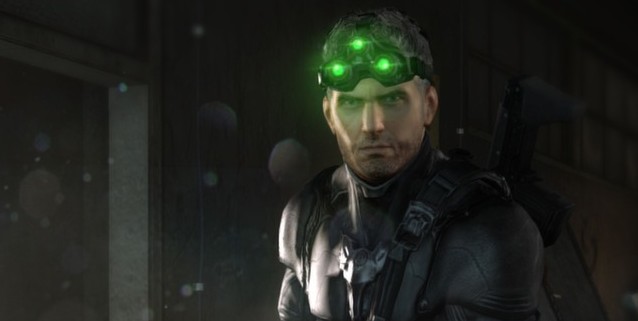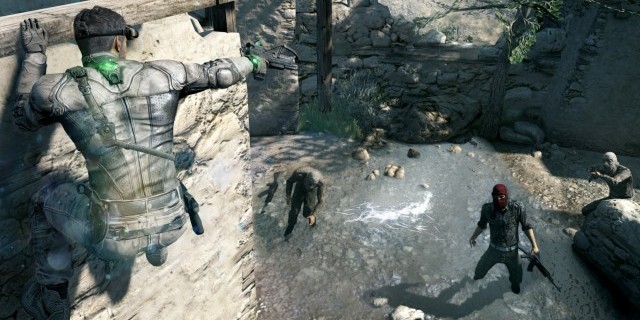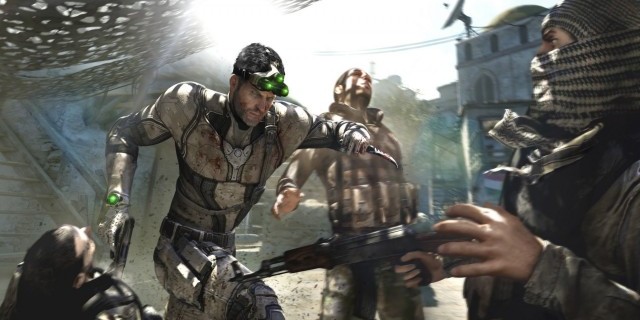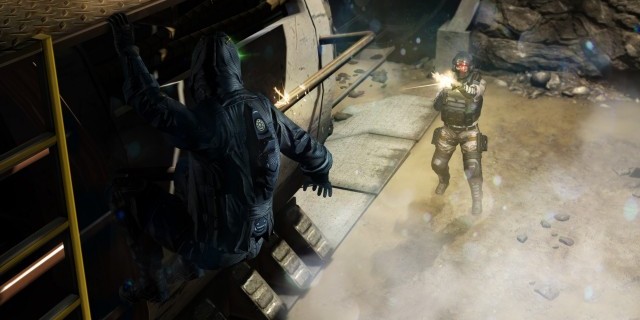
It’s been three years since we last saw Sam Fisher in action in Splinter Cell: Conviction, an entry that eschewed the usual stealth trappings in favor of heavy-duty tactical action. Many fans of the series didn’t care for the direction the series was taking and, if Blacklist is any indication, Ubisoft paid attention. Blacklist is easily the best, most fully-featured game in the series since Chaos Theory.
In Splinter Cell: Blacklist, America is faced with a sudden series of terrorist attacks followed by a threat of more every week. Naturally, the government turns to Fisher for help, giving him command of the newly-formed Fourth Echelon to find those responsible for The Blacklist, the name for the series of strikes aimed at America.
As the commander, you have a host of choices to make and things to do between missions, from upgrading the aircraft that serves as your mobile base (giving you various perks) to upgrading and customizing your equipment, weapons and loadout. You can even choose which missions you do next. Single player, co-op and multiplayer selections are all present in the same in-game menu, and all share a joint cash fund for equipment and weapons. The single player and co-op missions are all theoretically part of the same story, though the co-op quests won’t actually affect the storyline.

In Blacklist, Fisher has more options than ever on how to complete objectives. While Conviction focused on tactical action and previous entries focused entirely on stealth action, Blacklist allows you to choose how to handle everything on the fly. Specifically, there are three styles of play, and you’ll gain points and money for using their related actions. There’s the classic Ghost style, the realm of stealthy non-lethal actions; Panther, which is stealthy and deadly; and Assault, which is exactly what it sounds like.
You can choose how to approach each situation, going with a mix of styles (intentionally or not), or simply try to beat every mission using exclusively one kind. You’ll be rewarded with more money and in-game achievements for doing so. One note of warning if you choose Assault: Fisher is more frail than in previous games, and will die with just a few wounds, though he will heal up after a few seconds of hiding. One definite benefit of this focus on choice is that there are very few fail conditions, a major frustration in past games.
Many levels in Blacklist are built specifically with the purpose of being open-ended in approach, though most situations will always lend themselves to one or another. While I preferred utilizing non-lethal and stealthy maneuvers, anytime there was a dog around, I inevitably triggered alarms and went into full-on open combat against every enemy in the vicinity. Thankfully, the controls and camera are on par with most third-person shooters, so I’m not any worse at aiming here than I usually am.

The Wii U version
There are a number of Wii U-exclusive features, such as off-screen play using the GamePad or selecting weapons or gadgets by tapping the screen instead of using the equipment wheel. For some reason, the Wii U version also has much worse loading times than the other versions, on the scale of minutes at times. Unlike many Wii U games, it also supports the Pro Controller, and feels completely at home on it.
Additionally, while the Mark and Execute mechanism returns, it has been changed enough that it isn’t necessarily a Win Button. In order to use it, you must charge it up via stealth takedowns or by openly killing four enemies. At that point, Sam can mark up to three enemies and, if they are in range and sight, take them out quickly and efficiently. It still feels overpowered, but in a satisfying and enjoyable way. Quietly taking out a sentry, then marking and executing everyone in the room he was guarding without any of them even knowing you’re there simply illustrates how awesome Sam Fisher is.
The campaign is about 12 hours if you don’t die too often, but the co-op content can easily take almost as long. For most of the co-op missions, you can actually play them solo if you really want. There’s no local co-op, unfortunately, so if you want to play them with others, you’ll have to go online. The missions are fun, but don’t have the same feel as the main campaign, possibly because of the lack of a story impact.

For competitive play, Ubisoft brought back the popular Spies vs. Mercs mode of the classic entries, and it is just as much fun as it used to be. It pits stealthy spies versus heavily-armed and armored mercenaries, as the spies try to hack terminals and the mercenaries try to stop them. You can play in two-on-two or four-on-four matches in a variety of modes, including deathmatch (which allows mixed teams, but is actually the least compelling mode present). If a community grows around it, it’s compelling enough to give Blacklist plenty of staying power.
Blacklist looks very impressive, though most of enemies are carbon copies of each other, and only important characters get much in the way of detail. The environments definitely look nice, but since most of the time you’ll probably be trying to stay in darkness, a lot of its impact is lost. The sound effects and voice acting are top-notch, even though Michael Ironside doesn’t return as the voice of Sam Fisher. The new voice actor does a fine job, but you’ll definitely notice the change.
Ubisoft, in listening to feedback for Conviction, managed to meld that more action-heavy style with a return to the classic stealth that brought the series to prominence in the first place. By taking the best of both gameplay philosophies and giving the players the choice of how to play, Ubisoft has crafted a game that any fan of action games should enjoy.
Pros: Complete loadout and upgrade customization, tons of content
Cons: Loading screens, Michael Ironside doesn’t voice Fisher



















